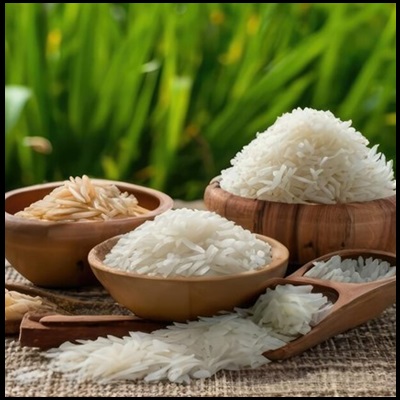Microbiological profile of paddy and commercial rice (Oryza sativa L) in the department of Norte de Santander, Colombia.
Perfil microbiológico del arroz (Oryza sativa L) tipo paddy y comercial en el departamento Norte de Santander, Colombia.
DOI:
https://doi.org/10.24054/bistua.v22i2.2985Keywords:
Microbiological analysis, rice, microbial contamination, food safetyAbstract
Rice (Oryza sativa L.) is a globally important food, and in Colombia, it ranks as the third-largest crop, covering 25,000 hectares and yielding over 180,000 tons annually. This study assessed the microbiological profile of rice cultivated and marketed in the Norte de Santander department, analyzing 55 samples from the main production areas (Cúcuta, El Zulia, Tibú, and Puerto Santander). Total coliforms, Escherichia coli, mesophilic aerobes, molds, and yeasts were quantified. In paddy rice, high levels of total coliforms (5.37 log CFU/g) and E. coli (3.23 log CFU/g) were found, while in commercial rice, these values met the established standards. Counts of mesophilic aerobes and molds and yeasts were elevated in both paddy and commercial rice. These findings suggest deficiencies in irrigation water management and grain storage, posing a public health risk due to the potential production of mycotoxins. Therefore, effective strategies are needed to control microorganisms and ensure rice safety throughout the food supply chain.
Downloads
References
Bolsa mercantil Colombia, «Análisis de producto: ARROZ». 2023, [En línea]. Disponible en: https://www.bolsamercantil.com.co/sites/default/files/2023-02/Analisis_producto_ARROZ_150223.pdf.
MinAgricultura., «Bullets Arroz. Ministerio de Agricultura y Desarrollo Rural.», 2021.
N. Magan, D. Aldred, K. Mylona, y R. J. W. Lambert, «Limiting mycotoxins in stored wheat», Food Addit. Contam. - Part A, vol. 27, n.o 5, pp. 644-650, 2010, doi: 10.1080/19440040903514523.
N. Magan y D. Aldred, «Post-harvest control strategies: Minimizing mycotoxins in the food chain», Int. J. Food Microbiol., vol. 119, n.o 1-2, pp. 131-139, 2007, doi: 10.1016/j.ijfoodmicro.2007.07.034.
Phan, L.T.K., Tran, T., Audenaert, K., Jacxsens, L., Eeckhout, M., «Contamination of Fusarium proliferatum and Aspergillus flavus in the rice chain linked to crop seasons, cultivation regions, and traditional agricultural practices in Mekong Delta. Vietnam.», Foods, vol. 10(9), 2021, doi: https://doi.org/10.3390/foods10092064.
J. Hussain, N., Khan, S., Qasim, M., & Iqbal, «Microbiological Quality of Processed Rice Grains.», Int. J. Agric. Biol., vol. 19(6), pp. 1190-1194, 2017.
E. M. Abdallah, E. M., Elsayed, A. A., Kamal, R. M., & Elmahdy, «Microbiological quality of rice and its processing environment.», Food Sci. Technol., vol. 38(1), pp. 215-220., 2018.
International Commission on Microbiological Specifications for Foods (ICMSF), Microorganismos de los alimentos. Técnica de análisis microbiológico. Vol 1., Editorial. Zaragoza. España., 1982.
Y. Lugo y E. Marino, «Inocuidad en granos», p. 2, 2017, [En línea]. Disponible en: https://ciatej.repositorioinstitucional.mx/jspui/bitstream/1023/636/1/cap Incouidadgranos.pdf.
V. O. Camacho A, Giles M, Ortegón A, Palao M, Serrano B, «Técnicas para el análisis microbiológico de alimentos, UNAM. México. Disponible en: pdf Fecha de consulta: enero de 2018.», 2018, [En línea]. Disponible en: http://depa.fquim.unam.mx/amyd/archivero/TecnicBasicas-Colif-tot-fecales-Ecoli-NMP_6529.
M. J. Lee, S. Y. Park, y S. Do Ha, «Reduction of coliforms in rice treated with sanitizers and disinfectants», Food Control, vol. 18, n.o 9, pp. 1093-1097, 2007, doi: 10.1016/j.foodcont.2006.07.008.
G.-B. L. Ríos-Tobón S, Agudelo-Cadavid RM, «Patógenos e indicadores microbiológicos de calidad del agua para consumo humano.», Rev. Fac. Nac. Salud Pub. 2017; 35(2) 236-247., 2017.
Corponor, «INTERPRETACIÓN VARIABLES CRUZADAS El análisis de las variables cruzadas permite comprender y evaluar los resultados obtenidos en los distintos ensayos realizados en cada punto de muestreo o ID . También permite establecer la relación directa o inversa ent», pp. 42-56, 2023, [En línea]. Disponible en: https://corponor.gov.co/web/index.php/boletin-ambiental/calidad-del-agua/.
Him Fábrega José J; Katherine NúñezAnabel, «CONTAMINACIÓN POR COLIFORMES Y EN LAS CERCANÍAS DE LA EVALUATION OF THE WATER NEAR THE MOUTH Revista Colegiada de Ciencia», Rev. colegiada ciencia, Univ. Panama, vol. 3, pp. 1-16, 2022, [En línea]. Disponible en: http://portal.amelica.org/ameli/journal/334/3342999006/.
C. A. R. de F. N. Corponor, «Calidad del agua rio Zulia», 2019, [En línea]. Disponible en: https://corponor.gov.co/calidad_agua/2019/RIO_ZULIA/8_CRUCE_VARIALBES_PARAMETRO_RIO_ZULIA.pdf.
M. N. Islam et al., «Food safety knowledge and handling practices among household food handlers in Bangladesh: A cross-sectional study», Food Control, vol. 147, n.o December 2022, p. 109578, 2023, doi: 10.1016/j.foodcont.2022.109578.
A. Pitt, J. & Hocking, «Fungi and food spoilage.», New York Springer-Verlag., 2009.
P. Chandravarnan, D. Agyei, y A. Ali, «Green and sustainable technologies for the decontamination of fungi and mycotoxins in rice: A review», Trends Food Sci. Technol., vol. 124, n.o June 2021, pp. 278-295, 2022, doi: 10.1016/j.tifs.2022.04.020.
N. Ali, «Co-occurrence of citrinin and ochratoxin A in rice in Asia and its implications for human health», J. Sci. Food Agric., vol. 98, n.o 6, pp. 2055-2059, 2018, doi: 10.1002/jsfa.8667.
C. Torrent et al., «Role of sfk1 gene in the filamentous fungus Penicillium roqueforti», Front. Microbiol., vol. 8, n.o DEC, pp. 1-11, 2017, doi: 10.3389/fmicb.2017.02424.
CODEX ALIMENTARIUS., «Código Internacional de Prácticas Recomendado – Principios Generales de Higiene de los Alimentos.», 2018.
E. Fernández, «Microbiología e inocuidad de los alimentos. Universidad Autónoma de Querétaro: México D.F.», 2000.
R. Abadía, B. y Bartosik, «Manual de buenas prácticas en postcosecha de granos: hacia el agregado de valor en origen de la producción primaria.», Buenos Aires: INTA., 2013.
S. Jian, F. y Jayas, «Ecosystem approach to grain storage.», Agric. Res. 1(2), p. pp.148–156, 2012.
D. Cahagnier, B., Lesage, L. y Richard-Molard, «Mould growth and conidiation in cereal grains as affected by water activity and temperature.», Lett. Appl. Microbiol. 17(1), pp. 7–13., 1993.
S. V. Marin S, Ramos AJ, Cano-Sancho G, «Mycotoxins: occurrence, toxicology, and exposure assessment.», Food Chem Toxicol., vol. 60, pp. 218-37, 2013.
J. Troestch y A. Vega, «Control de los niveles de micotoxinas del arroz consumido en Panamá, como parámetro de inocuidad.», Rev. Plus Econ., vol. 7, n.o 1, pp. 32-42, 2018.
A. Neme, K., & Mohammed, «Mycotoxin occurrence in grains and the role of postharvest management as a mitigation strategies.», A Rev. Food Control., vol. 78, pp. 412-425, 2017, doi: https://doi.org/10.1016/j.foodcont.2017.03.012.

Additional Files
Published
Issue
Section
License
Copyright (c) 2024 © Autores; Licencia Universidad de Pamplona

This work is licensed under a Creative Commons Attribution-NonCommercial-NoDerivatives 4.0 International License.
© Autores; Licencia Universidad de Pamplona





